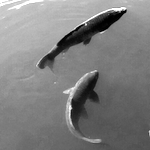Crowd movements can be observed across species and scales: from insects to mammals but also in non-cognitive systems such as eukaryotic cells. We are interested in the collective behavior of small fish and try understand the effect of external physical perturbations. First, I will present a numerical model coupling rheotaxis and social interactions. We show that social interactions improve the rheotaxis abilities of fish[1]. Second, we asked what happens when gregarious animals must momentarily adopt an individual behavior. To question the balance between collective and individual behaviors, a school of Neons (Paracheirodon innesi) was forced to cross a constriction[2]. This experiment is reminiscent of a panicked crowd escaping through a narrow gate. Using a statistical analysis developed for granular material and applied to crowd evacuation, our results clearly show that unlike human crowds or herds of sheep, no clogging is formed at the bottleneck. Fish do not collide and wait by respecting their social distance and a minimum waiting time between two successive exits. When the bottleneck begins to be comparable to or smaller than their social distance, the individual domains set by this cognitive distance must deform and fish density increases. We show that the current of escaping fish behaves like a set of deformable 2D-bubbles, their 2D domain, passing through a constriction. Schools of fish show that, by respecting social rules, a crowd of individuals can evacuate without clogging, even in an emergency situation.
[1] R Larrieu, C Quilliet, A Dupont, P Peyla - Phys.Rev. E (2021)
[2] R Larrieu, P Moreau, C Graff, P Peyla, A Dupont - arXiv:2212.12514 (2022)

 PDF version
PDF version
